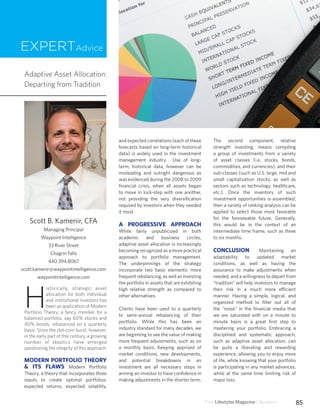
Adaptive Asset Allocation: Departing from Tradition
- 1. 85Fine Lifestyles Magazine Cleveland Adaptive Asset Allocation: Departing from Tradition Scott B. Kamenir, CFA Managing Principal Waypoint Intelligence 33 River Street Chagrin Falls 440.394.8067 scott.kamenir@waypointintelligence.com waypointintelligence.com EXPERTAdvice H istorically, strategic asset allocation for both individual and institutional investors has been an application of Modern Portfolio Theory, a fancy moniker for a balanced portfolio, say 60% stocks and 40% bonds, rebalanced on a quarterly basis. Since the dot-com burst, however, in the early part of this century, a growing number of skeptics have emerged questioning the integrity of this approach. MODERN PORTFOLIO THEORY & ITS FLAWS Modern Portfolio Theory, a theory that incorporates three inputs to create optimal portfolios: expected returns, expected volatility, and expected correlations (each of these forecasts based on long-term historical data) is widely used in the investment management industry. Use of long- term, historical data, however can be misleading and outright dangerous as was evidenced during the 2008 to 2009 financial crisis, when all assets began to move in lock-step with one another, not providing the very diversification required by investors when they needed it most. A PROGRESSIVE APPROACH While fairly unpublicized in both academic and business circles, adaptive asset allocation is increasingly becoming recognized as a more practical approach to portfolio management. The underpinnings of the strategy incorporate two basic elements: more frequent rebalancing, as well as investing the portfolio in assets that are exhibiting high relative strength as compared to other alternatives. Clients have been used to a quarterly to semi-annual rebalancing of their portfolio. While this has been an industry standard for many decades, we are beginning to see the value of making more frequent adjustments, such as on a monthly basis. Keeping apprised of market conditions, new developments, and potential breakdowns in an investment are all necessary steps in arming an investor to have confidence in making adjustments in the shorter term. The second component, relative strength investing, means compiling a group of investments from a variety of asset classes (i.e. stocks, bonds, commodities, and currencies), and their sub-classes (such as U.S. large, mid and small capitalization stocks, as well as sectors such as technology, healthcare, etc.). Once the inventory of such investment opportunities is assembled, then a variety of ranking analysis can be applied to select those most favorable for the foreseeable future. Generally, this would be in the context of an intermediate time frame, such as three to six months. CONCLUSION Maintaining an adaptability to updated market conditions, as well as having the assurance to make adjustments when needed, and a willingness to depart from “tradition” will help investors to manage their risk in a much more efficient manner. Having a simple, logical, and organized method to filter out all of the “noise” in the financial media that we are saturated with on a minute to minute basis is a great first step to mastering your portfolio. Embracing a disciplined and systematic approach, such as adaptive asset allocation, can be quite a liberating and rewarding experience, allowing you to enjoy more of life, while knowing that your portfolio is participating in any market advances, while at the same time limiting risk of major loss.
